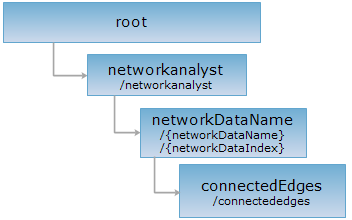URI
<networkDataName_uri>/connectededges[.<format>]
Supported methods
Parent resource
Introduction
connectedEdges represents connectivity analysis. By sending a Get request to connectedEdges, the system can find the connected nodes and edges according to the specified node or edge.
Supported Methods:
- GET: Finds the connected nodes and edges according to the specified node or edge.
- HEAD: Checks whether the connectedEdges resource exists, or if the current user has the authority to access the connectedEdges resource.
Supported output formats: RJSON, JSON, HTML, XML.
Resource hierarchy

HTTP request methods
Execute HTTP request on the following URI, here we take rjosn as the output format as an example. Where, supermapiserver is the server name.
http://supermapiserver:8090/iserver/services/transportationAnalyst-facilityNet/rest/networkanalyst/WaterNet@FacilityNet/connectededges.rjson
GET request
Finds the connected nodes and edges according to the specified node or edge.
Request parameter
To execute a GET request on connectedEdges resource, the URI should contain the following parameters:
| Name | Type | Description |
| connected | boolean | Whether to find connected edges or unconnected edges. true indicates finding connected edges, while false will find unconnected edges. |
| returnFeatures | boolean | Whether to return a detailed description of the result feature. false indicates only returning the IDs of the features. |
| edgeIDs | int[] | The IDs of the connected edges of the analysis result. |
| nodIDs | int[] | The IDs of the connected nodes of the analysis result. |
Response structure
After executing connectivity analysis, the response fields of the result representation are as follows:
| Name | Type | Description |
| cost | double | The cost of the connectivity analysis. |
| edges | int[] | The IDs of the result edges. |
| edgesFeatures | Feature[] | The detailed information of the result edges. |
| nodes | int[] | The IDs of the result nodes. |
| nodesFeature | Feature[] | The detailed information of the result nodes. |
Response example
Execute connectivity analysis to sample dataset "WaterNet@FacilityNet", ie., sending a GET request by using the following URI:
http://supermapiserver:8090/iserver/services/transportationAnalyst-facilityNet/rest/networkanalyst/WaterNet@FacilityNet/connectededges.rjson?connected=true&returnFeatures=true&edgeIDs=[401,420,57]
A part of the analysis result is as follows:
HEAD request
Returns the same HTTP response header as the GET request, but no response entity, which can be used to retrieve the meta data contained in response message header without having to transmit the entire response content. Meta data information includes media type, character coding, compression coding, entity content length, etc.
HEAD request is used to determine whether the connectedEdges resource exists, or if the user has the authority to access it. By executing an HEAD request with a .<format> URI, you can quickly determine whether the connectedEdges resource supports the <format> representation.